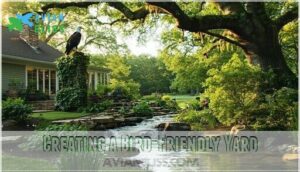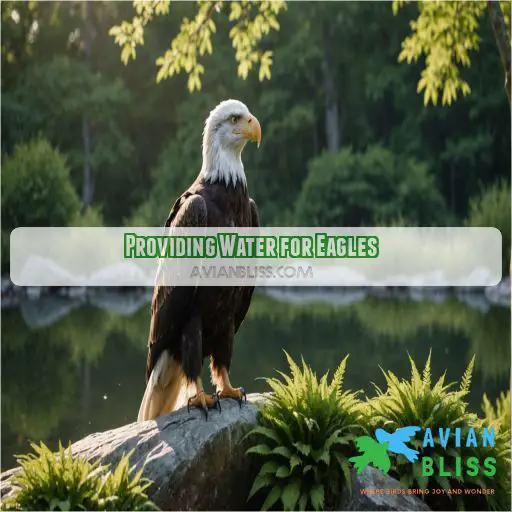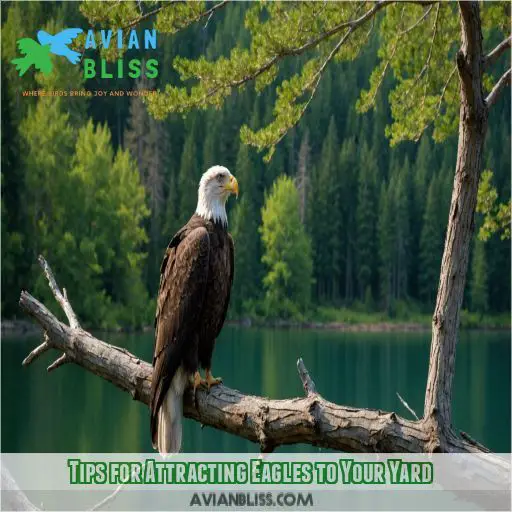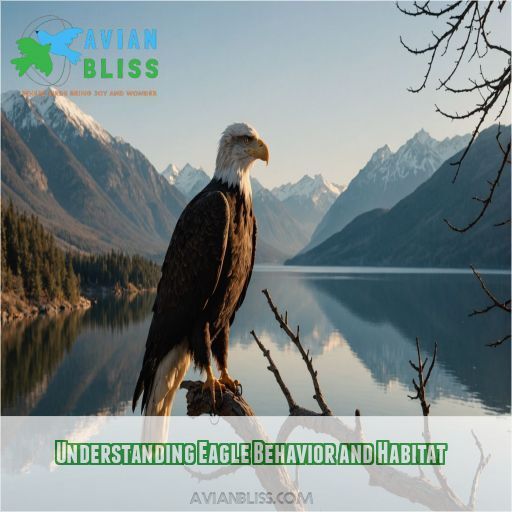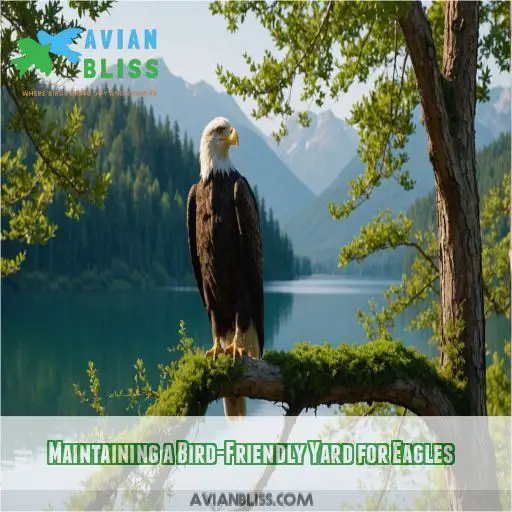This site is supported by our readers. We may earn a commission, at no cost to you, if you purchase through links.
1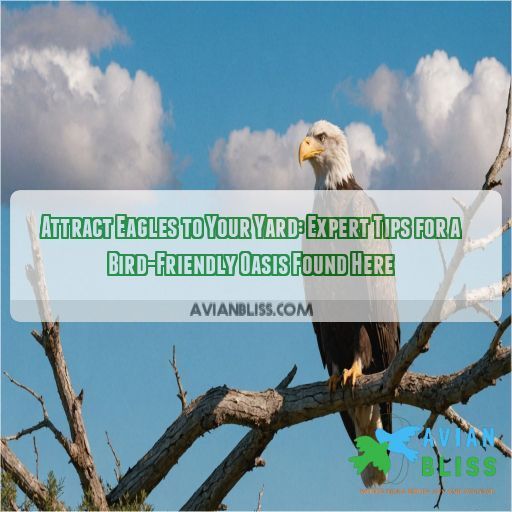
Start by planting native species that provide food, shelter, and habitat for these majestic birds.
Choose trees like oak, pine, or maple that offer sturdy perches and nesting sites.
Don’t forget to provide a source of fresh water, like a bird bath or small pond.
And, of course, avoid using those pesky insecticides and pesticides that can harm eagles and their prey.
Table Of Contents
- Key Takeaways
- Creating a Bird-Friendly Yard
- Choosing the Right Food for Eagles
- Providing Water for Eagles
- Attracting Eagles With Birdhouses and Nest Boxes
- Tips for Attracting Eagles to Your Yard
- Understanding Eagle Behavior and Habitat
- Maintaining a Bird-Friendly Yard for Eagles
- Frequently Asked Questions (FAQs)
- How do you attract wild eagles?
- What is an eagles favorite food?
- How do you befriend an eagle?
- What attracts a bald eagle?
- What time of day are eagles most active outdoors?
- Can I keep eagles as pets in my backyard safely?
- How do I protect my pets from eagles in yard?
- What are the best trees for eagles to nest in?
- Can I feed eagles by hand in my yard safely?
- Conclusion
Key Takeaways
- You’ll want to start by planting native species in your yard, which provide essential food, shelter, and habitat for eagles and other bird species – think of it as setting up a cozy Airbnb for your feathered friends!
- Providing a diverse range of food sources is key, including fish, small mammals, and carrion, so consider their natural hunting habits and offer food that mimics their usual prey – basically, you’re trying to create an eagle-sized snack bar!
- Don’t forget to install a bird bath or small pond with fresh, clean water, as eagles need a reliable water source for drinking and bathing – it’s like setting up a spa day for these majestic birds!
- Finally, avoid using insecticides and pesticides, which can harm eagles and their prey, and instead opt for organic gardening methods and natural pest control – you’re aiming to create a toxin-free zone that’s safe for your eagle friends to hang out in!
Creating a Bird-Friendly Yard
You’re excited to turn your yard into a haven for eagles, but where do you start?
By focusing on creating a bird-friendly yard, you’ll be well on your way to attracting these majestic birds and supporting their well-being.
You can start by:
- Planting native species
- Providing food sources
- Offering water and bathing areas
- Creating shelter and cover specifically for eagles (Source)
Planting Native Species for Eagles
To create an eagle-friendly yard, start by planting native species that thrive in your region. These plants provide essential food, shelter, and habitat for eagles and other bird species. By choosing regional plant choices, you’ll support seed dispersal, plant diversity, and a thriving wildlife habitat in your own backyard.
Providing Food Sources for Eagles
To attract eagles, provide a diverse range of food sources, including fish, small mammals, and carrion (Source). Consider their natural hunting habits and offer food that mimics their usual prey. Here are some tips to get you started:
- Use bird feeders that cater to eagles’ large size and strength
- Offer high-quality bird food, such as fish and meat
- Avoid using insecticides and pesticides, which can harm eagles and their prey
- Create a carcass availability by placing dead fish or small mammals in your yard
- Make sure your yard provides a reliable food source for eagles (Source)
Offering Water and Bathing Areas
To attract eagles, don’t forget a reliable water source! Install a bird bath or small pond with fresh, clean water. Consider a bath with a depth of 2-3 inches and a wide enough area for eagles to comfortably land and take off, keeping them safe from predators.
Creating Shelter and Cover for Eagles
To create shelter and cover for eagles, consider these essentials:
- Plant eagle-safe trees like oak, pine, or maple to provide habitat restoration and shelter from harsh weather.
- Install a nesting box with predator guards to help eagles choose a safe nest site.
- Offer nesting materials like twigs and leaves near the nesting box.
Choosing the Right Food for Eagles
You’re ready to take your bird-friendly yard to new heights by attracting eagles, but first, you need to choose the right food to entice these majestic birds to visit and stay. By focusing on high-quality food sources and avoiding insecticides and pesticides, you’ll be well on your way to creating a welcoming oasis for eagles and other birds alike.
High-Quality Food Sources for Eagles
As an eagle enthusiast, you want to provide the best food sources for these majestic birds. Focus on offering high-quality prey like fish, which are rich in protein . Make sure fish are readily available by maintaining a clean and well-stocked bird bath or pond . You can also provide carcass sources, like a roosting box or a clean birdhouse , to support their hunting success.
Avoiding Insecticides and Pesticides
When creating a bird-friendly oasis, ditch the insecticides and pesticides!
These chemicals can harm eagles and their food sources.
Instead, opt for organic gardening methods and natural pest control.
Plant bee balm and other native species that attract beneficial insects.
This approach protects eagles and also reduces environmental impact.
Using Bird Feeders and Seed Trays
- Choose seed trays that are specifically designed for large birds like eagles.
- Offer a variety of seeds, such as sunflower seeds and Nyjer seeds.
- Place feeders at least 10 feet off the ground to prevent predators from reaching them.
- Clean and maintain feeders regularly to prevent mold and bacterial growth.
Providing Water for Eagles
You’re one step closer to creating an eagle-friendly haven in your yard – now it’s time to provide the essential ingredient for these magnificent birds: water. By installing bird baths, ponds, and maintaining clean water sources, you’ll be offering a welcome oasis for eagles to drink, bathe, and thrive.
Installing Bird Baths and Ponds
Install a bird bath or pond with a depth of 2-3 inches, placing it near a tree for safe perches. Aim for a pond size of at least 4×4 feet.
Maintaining Clean Water Sources
Now that you’ve installed bird baths and ponds, it’s really important to maintain clean water sources to keep your feathered friends healthy and safe from chemical hazards and algae growth.
Offering Fresh Water for Drinking
Now that you’ve maintained clean water sources, it’s time to offer fresh water for drinking! Make sure your water source is free from contaminants and easily accessible to eagles.
- Use a shallow dish or birdbath with fresh water and a few rocks for perching.
- Change the water frequently to prevent bacterial growth.
- Consider installing a rainwater harvesting system for a natural water source.
- Keep the water source at least 10 feet away from any structures to prevent collisions.
Planting Trees and Shrubs for Cover
Plant eagle-friendly trees and shrubs like native conifers, oaks, or dogwoods, providing year-round cover and nesting sites. Consider winter cover needs, too, to create a cozy haven for these majestic birds.
Providing Perches and Nesting Sites
When providing perches and nesting sites for eagles, choose sturdy trees with a height of at least 60 feet, and offer natural nesting materials like twigs and leaves nearby.
Creating a Safe Haven From Predators
To create a safe haven from predators, consider installing predator-proof fencing and providing safe nesting sites with natural deterrents, while identifying potential predators and ensuring habitat security around your yard.
Attracting Eagles With Birdhouses and Nest Boxes
You can entice eagles to make your yard their home by installing birdhouses and nest boxes specifically designed for these majestic birds. By choosing the right birdhouse and placing it in a safe location, you’ll be providing a cozy space for eagles to nest and raise their young, making your yard a haven for these incredible creatures.
Choosing the Right Birdhouse for Eagles
When choosing a birdhouse for eagles, you’ll want to think about size, materials, and safety features. Opt for a spacious abode made from durable, weather-resistant materials like cedar or reclaimed wood. Make sure the entrance hole is large enough for eagles to comfortably enter and exit. A well-designed eagle house will make your feathered friends feel right at home.
Installing Birdhouses in Safe Locations
When installing birdhouses for eagles, prioritize predator-free zones with minimal human disturbance.
Choose sturdy trees with a wide canopy for shelter.
Mount nest boxes 10-15 feet off the ground, facing east to southeast for warmth.
Make sure you can easily reach the birdhouses to do maintenance and cleaning.
Create a schedule to regularly inspect and maintain the birdhouses, keeping your eagle friends safe and happy.
Providing Materials for Nesting and Raising Young
Now that you’ve installed your birdhouse in a safe location, it’s time to think about the next generation – providing materials for nesting and raising young birds!
You can encourage the birds to make themselves at home and raise their young in a safe and cozy habitat by adding some natural nesting materials like twigs, grasses, or moss near your nest box.
Tips for Attracting Eagles to Your Yard
You’re excited to invite these magnificent birds to your yard, but where do you start? By making a few simple tweaks to your outdoor space, such as avoiding invasive species and pesticides, creating a diverse and native plant garden, and providing a source of fresh water, you can turn your yard into an eagle-friendly oasis.
Avoiding Invasive Species and Pesticides
To attract eagles to your yard, ditch invasive species and pesticides. They harm native plants and wildlife, creating a toxic environment. Instead, adopt eco-friendly gardening practices and opt for natural pest control methods. Identify invasive plants and replace them with native species. Consult local resources for guidance on pesticide alternatives and native plant benefits. Your eagles will thank you!
Creating a Diverse and Native Plant Garden
Now that you’ve avoided those pesky invasive species and pesticides, it’s time to create a diverse and native plant garden.
Choose plants that are specific to your region and that will attract pollinators like bees and butterflies.
Source your seeds locally and design your garden with wildlife benefits in mind.
This will be a haven for eagles and other birds alike!
Providing a Source of Fresh Water
You want to attract eagles to your yard? Providing fresh water is key. Make sure the water is clean by changing it often. Create a bathing area with shallow water and a few rocks for perching. Consider these tips:
- Water depth: 2-4 inches for bathing and drinking
- Pond placement: Partial shade to prevent algae growth
- Water features: Add a small fountain or mister to create movement and sound
Understanding Eagle Behavior and Habitat
As you create your bird-friendly oasis, understanding eagle behavior and habitat is really important for attracting these majestic birds to your yard. By learning about their migration patterns, diet, and hunting habits, you’ll be able to tailor your yard to meet their unique needs and increase your chances of spotting an eagle soaring overhead.
Learning About Eagle Migration Patterns
As you learn about eagle migration patterns, you’ll discover that these birds travel along established routes, often between August and November.
Timing is everything, as they capitalize on food sources and favorable weather.
Factors like climate change, habitat loss, and hunting affect their journey.
Understanding Eagle Diet and Hunting Habits
Now that you’ve learned about eagle migration patterns, let’s talk about their diet and hunting habits. To attract eagles, you need to understand what they eat and how they hunt. Here are three key things to know:
- Eagle prey: mainly small mammals, fish, and birds
- Hunting techniques: stealthy, patient, and powerful, with talons that can kill instantly
- Habitat impact: open spaces with minimal human disturbance
Creating a Habitat That Supports Eagle Behavior
Now that you know what eagles eat and how they hunt, it’s time to create a habitat that supports their behavior.
Think about eagle nesting sites, prey availability, habitat security, water access, and predator control.
Provide a safe haven with native plants, a nearby water source, and minimal human disturbance.
Maintaining a Bird-Friendly Yard for Eagles
As you create a haven for eagles in your yard, remember that maintenance is key to keeping these majestic birds coming back. By regularly cleaning bird feeders and baths, maintaining a safe and healthy environment, and continuously providing food and water sources, you’ll be well on your way to becoming an eagle whisperer in your own backyard.
Regularly Cleaning Bird Feeders and Baths
Now that you’ve got a handle on eagle behavior and habitat, let’s get down to business: keeping those bird feeders and baths squeaky clean. You see, dirty feeders and baths can be breeding grounds for diseases that can harm your feathered friends. Here are four simple cleaning tips to keep your bird buddies healthy:
- Clean feeders every 1-2 weeks with a 1:9 vinegar-to-water solution
- Scrub baths with a stiff brush to remove debris and algae
- Rinse thoroughly to make sure the water is clean
- Dry with a clean towel to prevent bacterial growth
Maintaining a Safe and Healthy Environment
Now that you’ve got those bird feeders and baths sparkling, it’s time to think about the bigger picture. Maintaining a safe and healthy environment for eagles means controlling predators, reducing pollution, and ditching pesticides. Consider using natural deterrents like physical barriers or repellent plants to keep predators at bay. Your eagles will thank you for the safe haven!
Continuously Providing Food and Water Sources
To keep your eagle oasis thriving, you’ll want to continuously provide food and water sources. Think of it as setting a table for your feathered friends. Here’s how:
- Keep feeders filled with high-quality food sources like seeds, nuts, and fruits.
- Make sure the water is clean by changing it frequently.
- Place feeders strategically to avoid overcrowding.
- Clean bird baths regularly to prevent bacterial growth.
- Supplement with natural food sources like native plants and berries.
Frequently Asked Questions (FAQs)
How do you attract wild eagles?
To attract wild eagles, you’ll need to create a bird-friendly haven by providing food sources like berries and seeds, a fresh water source, shelter, and native plants that support a diverse insect population .
What is an eagles favorite food?
You’re curious about an eagle’s favorite food – primarily, they love fish, which makes up 70-90% of their diet, but they’re also opportunistic feeders, snatching up small mammals, carrion, and birds .
How do you befriend an eagle?
Imagine soaring on eagle’s wings! To befriend an eagle, you’ll need to earn its trust. Start by respecting its space, offering a safe haven, and providing a steady food supply, like fresh fish or carrion.
What attracts a bald eagle?
You can attract a bald eagle by offering a natural food source, like fish or small mammals, and providing a constant water source, such as a lake or a large pool of water .
What time of day are eagles most active outdoors?
You’re excited to spot eagles! They’re most active outdoors during early morning hours (sunrise to 9 am) and late afternoon (3 pm to sunset), so grab your binoculars and get ready for a thrilling bird-watching experience!
Can I keep eagles as pets in my backyard safely?
Sorry, it’s not possible to keep eagles as pets in your backyard safely. Eagles are protected by law, and their needs can’t be met in a home environment . Instead, consider creating a bird-friendly haven to attract them naturally.
How do I protect my pets from eagles in yard?
As you bask in the majesty of eagles soaring overhead, remember to shield your furry friends! Keep pets on a short leash, provide covered enclosures, and remove potential food sources to avoid attracting eagles to your yard.
What are the best trees for eagles to nest in?
You’re looking to host some eagles in your yard. Choose tall, sturdy trees like pines, spruces, or firs with a wide canopy and strong branches to support their massive nests .
Can I feed eagles by hand in my yard safely?
Feeding eagles by hand sounds thrilling, but imagine those sharp talons as, well, not exactly gentle dinner companions. Unfortunately, it’s not safe for you or the eagles, as they may associate humans with food, leading to negative outcomes.
Conclusion
Imagine this: eagles soaring overhead, their majestic wings spread wide, as they swoop down to nest in your yard.
Meanwhile, you’re sipping coffee, enjoying the show.
By following our expert tips, you can turn this vision into reality.
Plant native species, provide fresh water, and avoid those pesky pesticides.
With a little effort, you’ll be well on your way to attracting eagles to your yard, creating a bird-friendly oasis that’s a haven for these incredible birds.

